Economic Principles Report: Australia and Canada's Economic Policies
VerifiedAdded on 2023/04/20
|14
|2980
|128
Report
AI Summary
This report provides a comparative analysis of economic principles as applied in Australia and Canada. It begins by examining inflation targeting policies in both countries, detailing their implementation and contributions to economic performance, including trends in inflation, GDP growth, and unemployment. The report then explores impediments to the successful implementation of inflation targeting in Canada, focusing on financial stability concerns and structural changes in the economy. A significant portion of the report addresses fiscal policies adopted by both nations during the global financial crisis of 2008/09, outlining stimulus packages and government interventions. Finally, it discusses the negative effects of the recession on both economies, comparing their experiences and responses to the crisis. The report uses data and figures to support its analysis, drawing on various academic sources.
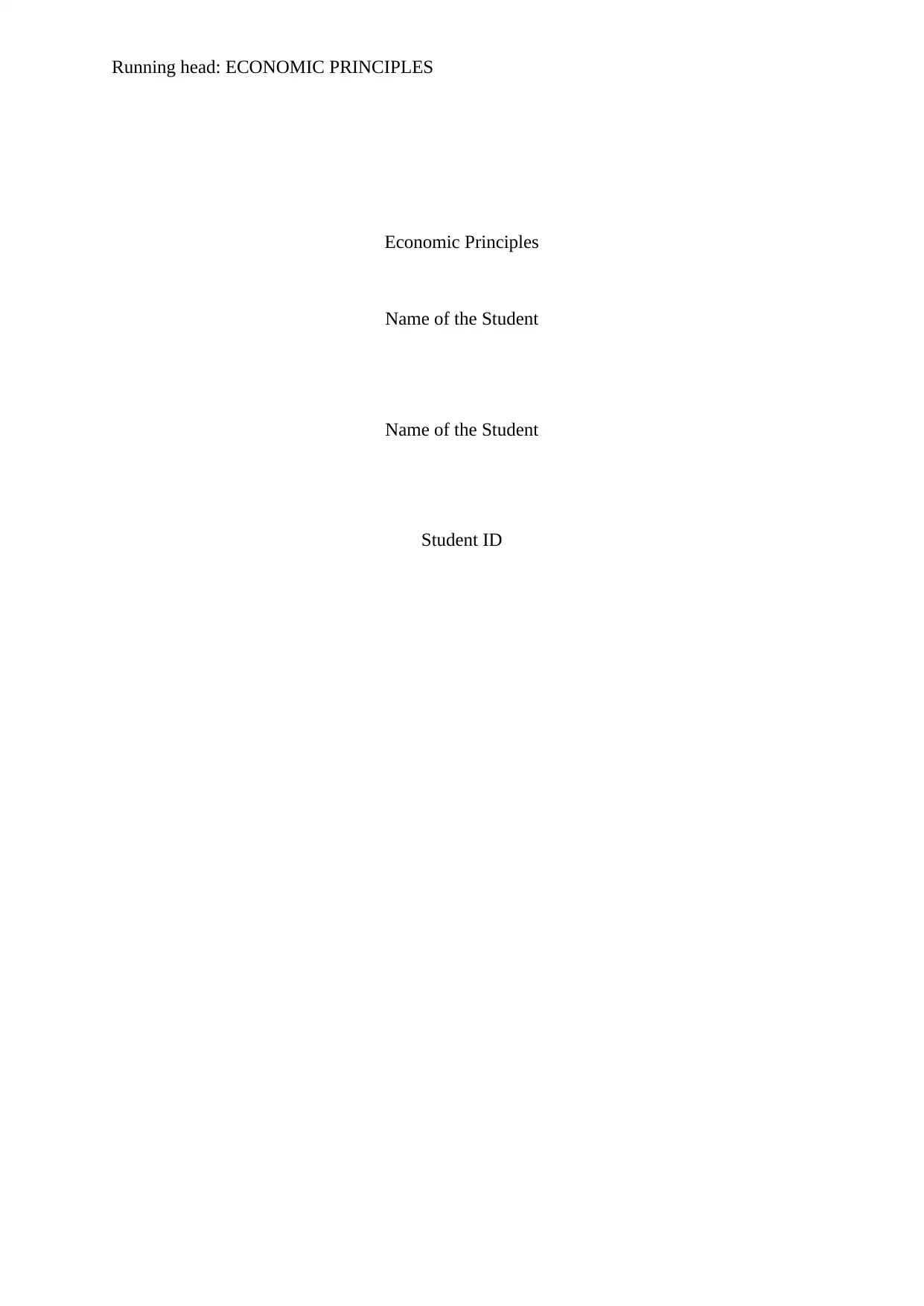
Running head: ECONOMIC PRINCIPLES
Economic Principles
Name of the Student
Name of the Student
Student ID
Economic Principles
Name of the Student
Name of the Student
Student ID
Paraphrase This Document
Need a fresh take? Get an instant paraphrase of this document with our AI Paraphraser
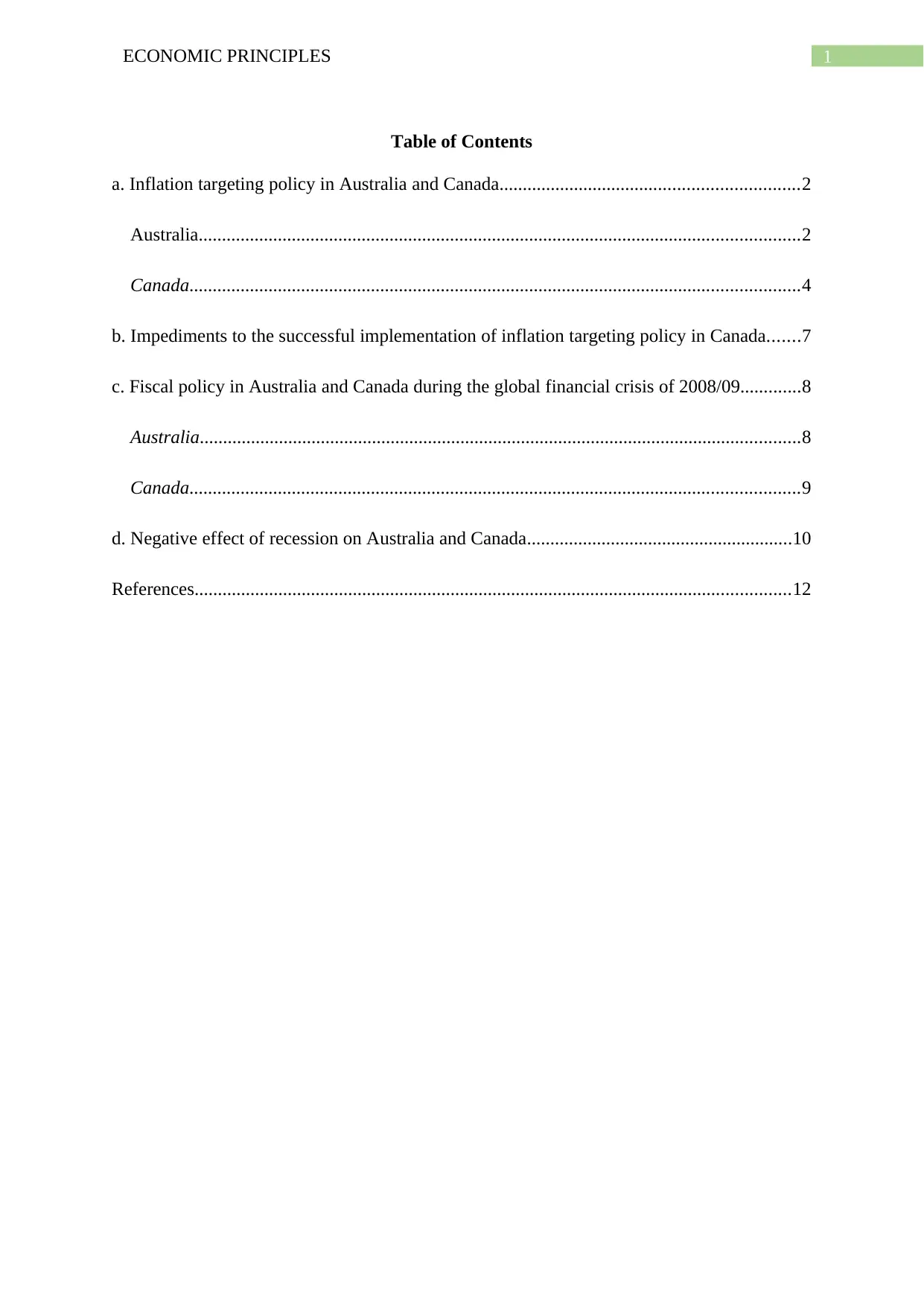
1ECONOMIC PRINCIPLES
Table of Contents
a. Inflation targeting policy in Australia and Canada................................................................2
Australia.................................................................................................................................2
Canada...................................................................................................................................4
b. Impediments to the successful implementation of inflation targeting policy in Canada.......7
c. Fiscal policy in Australia and Canada during the global financial crisis of 2008/09.............8
Australia.................................................................................................................................8
Canada...................................................................................................................................9
d. Negative effect of recession on Australia and Canada.........................................................10
References................................................................................................................................12
Table of Contents
a. Inflation targeting policy in Australia and Canada................................................................2
Australia.................................................................................................................................2
Canada...................................................................................................................................4
b. Impediments to the successful implementation of inflation targeting policy in Canada.......7
c. Fiscal policy in Australia and Canada during the global financial crisis of 2008/09.............8
Australia.................................................................................................................................8
Canada...................................................................................................................................9
d. Negative effect of recession on Australia and Canada.........................................................10
References................................................................................................................................12
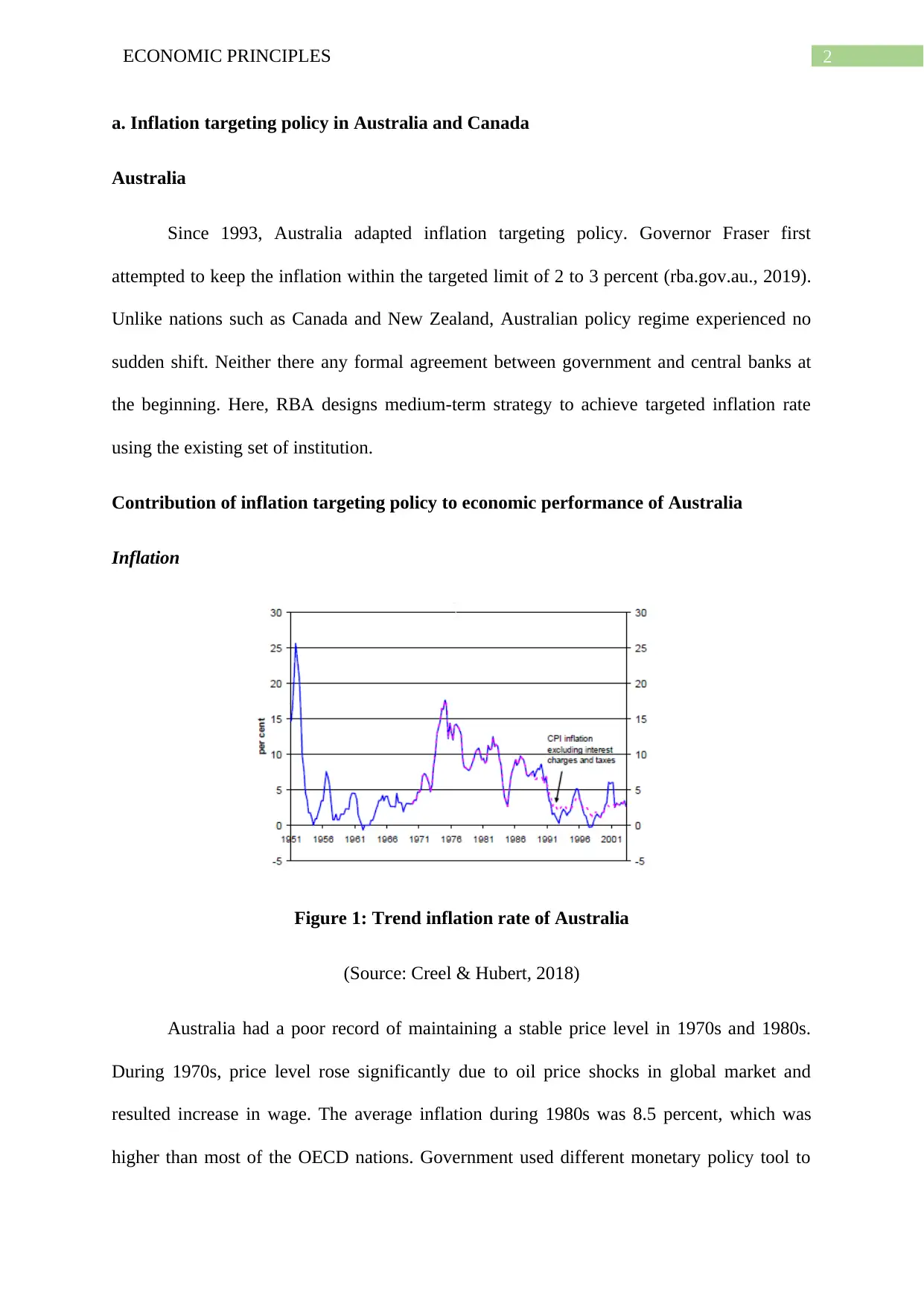
2ECONOMIC PRINCIPLES
a. Inflation targeting policy in Australia and Canada
Australia
Since 1993, Australia adapted inflation targeting policy. Governor Fraser first
attempted to keep the inflation within the targeted limit of 2 to 3 percent (rba.gov.au., 2019).
Unlike nations such as Canada and New Zealand, Australian policy regime experienced no
sudden shift. Neither there any formal agreement between government and central banks at
the beginning. Here, RBA designs medium-term strategy to achieve targeted inflation rate
using the existing set of institution.
Contribution of inflation targeting policy to economic performance of Australia
Inflation
Figure 1: Trend inflation rate of Australia
(Source: Creel & Hubert, 2018)
Australia had a poor record of maintaining a stable price level in 1970s and 1980s.
During 1970s, price level rose significantly due to oil price shocks in global market and
resulted increase in wage. The average inflation during 1980s was 8.5 percent, which was
higher than most of the OECD nations. Government used different monetary policy tool to
a. Inflation targeting policy in Australia and Canada
Australia
Since 1993, Australia adapted inflation targeting policy. Governor Fraser first
attempted to keep the inflation within the targeted limit of 2 to 3 percent (rba.gov.au., 2019).
Unlike nations such as Canada and New Zealand, Australian policy regime experienced no
sudden shift. Neither there any formal agreement between government and central banks at
the beginning. Here, RBA designs medium-term strategy to achieve targeted inflation rate
using the existing set of institution.
Contribution of inflation targeting policy to economic performance of Australia
Inflation
Figure 1: Trend inflation rate of Australia
(Source: Creel & Hubert, 2018)
Australia had a poor record of maintaining a stable price level in 1970s and 1980s.
During 1970s, price level rose significantly due to oil price shocks in global market and
resulted increase in wage. The average inflation during 1980s was 8.5 percent, which was
higher than most of the OECD nations. Government used different monetary policy tool to
⊘ This is a preview!⊘
Do you want full access?
Subscribe today to unlock all pages.

Trusted by 1+ million students worldwide
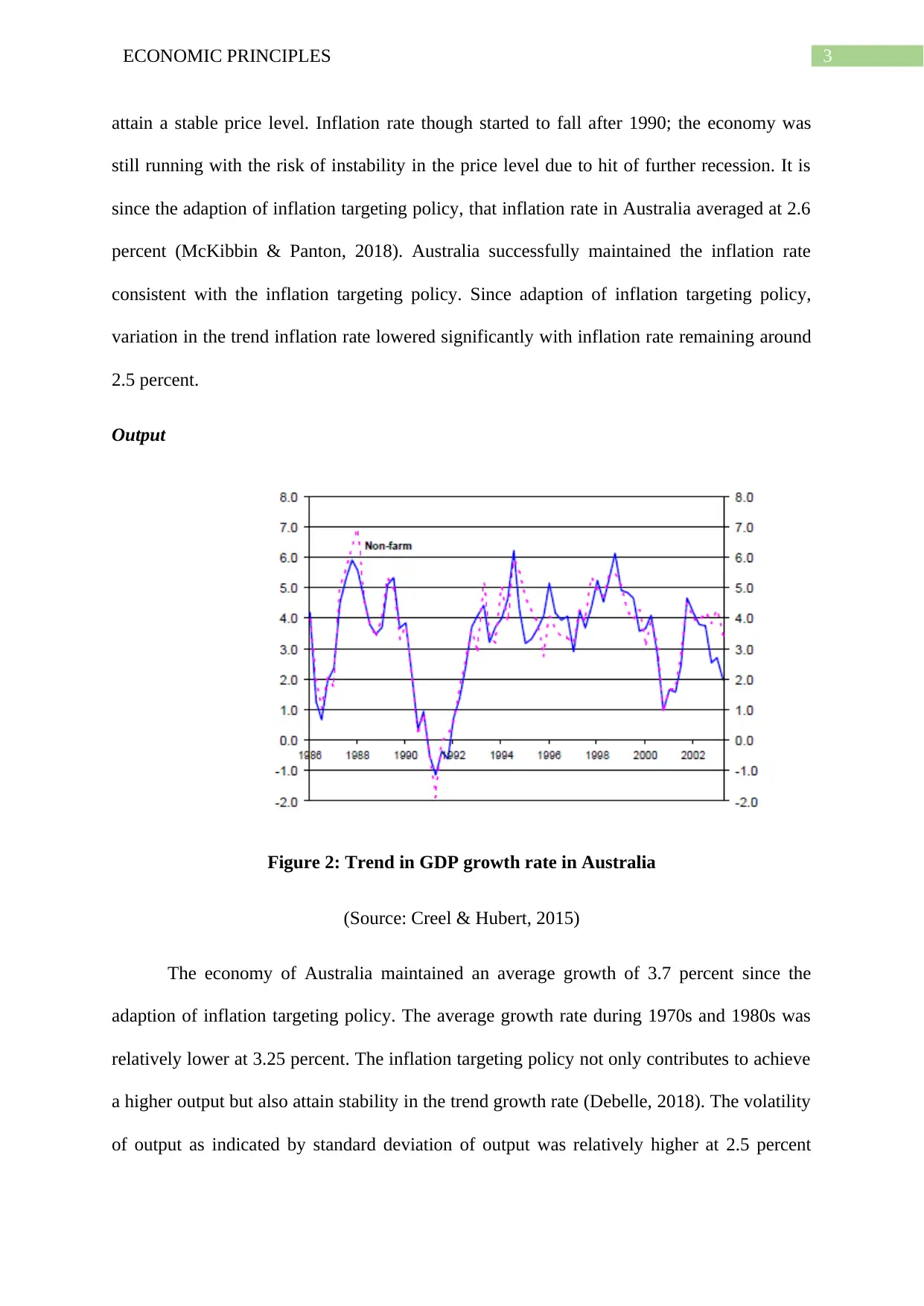
3ECONOMIC PRINCIPLES
attain a stable price level. Inflation rate though started to fall after 1990; the economy was
still running with the risk of instability in the price level due to hit of further recession. It is
since the adaption of inflation targeting policy, that inflation rate in Australia averaged at 2.6
percent (McKibbin & Panton, 2018). Australia successfully maintained the inflation rate
consistent with the inflation targeting policy. Since adaption of inflation targeting policy,
variation in the trend inflation rate lowered significantly with inflation rate remaining around
2.5 percent.
Output
Figure 2: Trend in GDP growth rate in Australia
(Source: Creel & Hubert, 2015)
The economy of Australia maintained an average growth of 3.7 percent since the
adaption of inflation targeting policy. The average growth rate during 1970s and 1980s was
relatively lower at 3.25 percent. The inflation targeting policy not only contributes to achieve
a higher output but also attain stability in the trend growth rate (Debelle, 2018). The volatility
of output as indicated by standard deviation of output was relatively higher at 2.5 percent
attain a stable price level. Inflation rate though started to fall after 1990; the economy was
still running with the risk of instability in the price level due to hit of further recession. It is
since the adaption of inflation targeting policy, that inflation rate in Australia averaged at 2.6
percent (McKibbin & Panton, 2018). Australia successfully maintained the inflation rate
consistent with the inflation targeting policy. Since adaption of inflation targeting policy,
variation in the trend inflation rate lowered significantly with inflation rate remaining around
2.5 percent.
Output
Figure 2: Trend in GDP growth rate in Australia
(Source: Creel & Hubert, 2015)
The economy of Australia maintained an average growth of 3.7 percent since the
adaption of inflation targeting policy. The average growth rate during 1970s and 1980s was
relatively lower at 3.25 percent. The inflation targeting policy not only contributes to achieve
a higher output but also attain stability in the trend growth rate (Debelle, 2018). The volatility
of output as indicated by standard deviation of output was relatively higher at 2.5 percent
Paraphrase This Document
Need a fresh take? Get an instant paraphrase of this document with our AI Paraphraser
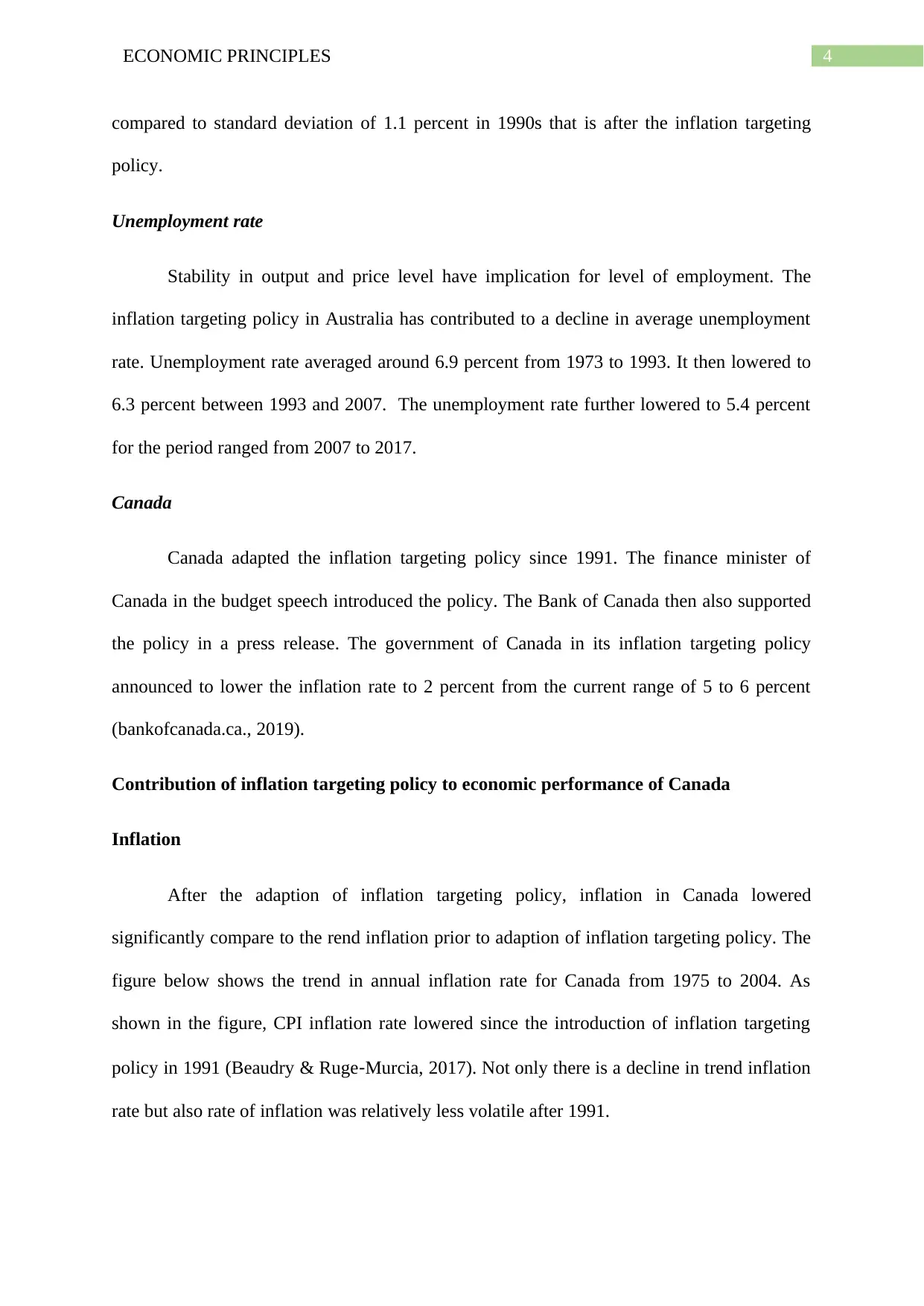
4ECONOMIC PRINCIPLES
compared to standard deviation of 1.1 percent in 1990s that is after the inflation targeting
policy.
Unemployment rate
Stability in output and price level have implication for level of employment. The
inflation targeting policy in Australia has contributed to a decline in average unemployment
rate. Unemployment rate averaged around 6.9 percent from 1973 to 1993. It then lowered to
6.3 percent between 1993 and 2007. The unemployment rate further lowered to 5.4 percent
for the period ranged from 2007 to 2017.
Canada
Canada adapted the inflation targeting policy since 1991. The finance minister of
Canada in the budget speech introduced the policy. The Bank of Canada then also supported
the policy in a press release. The government of Canada in its inflation targeting policy
announced to lower the inflation rate to 2 percent from the current range of 5 to 6 percent
(bankofcanada.ca., 2019).
Contribution of inflation targeting policy to economic performance of Canada
Inflation
After the adaption of inflation targeting policy, inflation in Canada lowered
significantly compare to the rend inflation prior to adaption of inflation targeting policy. The
figure below shows the trend in annual inflation rate for Canada from 1975 to 2004. As
shown in the figure, CPI inflation rate lowered since the introduction of inflation targeting
policy in 1991 (Beaudry & Ruge‐Murcia, 2017). Not only there is a decline in trend inflation
rate but also rate of inflation was relatively less volatile after 1991.
compared to standard deviation of 1.1 percent in 1990s that is after the inflation targeting
policy.
Unemployment rate
Stability in output and price level have implication for level of employment. The
inflation targeting policy in Australia has contributed to a decline in average unemployment
rate. Unemployment rate averaged around 6.9 percent from 1973 to 1993. It then lowered to
6.3 percent between 1993 and 2007. The unemployment rate further lowered to 5.4 percent
for the period ranged from 2007 to 2017.
Canada
Canada adapted the inflation targeting policy since 1991. The finance minister of
Canada in the budget speech introduced the policy. The Bank of Canada then also supported
the policy in a press release. The government of Canada in its inflation targeting policy
announced to lower the inflation rate to 2 percent from the current range of 5 to 6 percent
(bankofcanada.ca., 2019).
Contribution of inflation targeting policy to economic performance of Canada
Inflation
After the adaption of inflation targeting policy, inflation in Canada lowered
significantly compare to the rend inflation prior to adaption of inflation targeting policy. The
figure below shows the trend in annual inflation rate for Canada from 1975 to 2004. As
shown in the figure, CPI inflation rate lowered since the introduction of inflation targeting
policy in 1991 (Beaudry & Ruge‐Murcia, 2017). Not only there is a decline in trend inflation
rate but also rate of inflation was relatively less volatile after 1991.

5ECONOMIC PRINCIPLES
Figure 3: Trend in CPI and core inflation rate in Canada
(Source: Beaudry & Ruge‐Murcia, 2017)
The lower inflation of Canada was not only the result of adaption of inflation
targeting policy. Enhanced economic integration and globalization partly explain the
achieved stability in Canada during this time.
Output growth
It is often argued that inflation targeting policy achieves a stable and low targeted
inflation but at the cost of increased volatility in GDP growth. Like price level, the figure
below compared trend growth rate in GDP for the period from 1975 to 2004. From the figure,
it can be said that that inflation targeting policy in Canada was not result in a higher volatility
in GDP (Obstfeld et al., 2016). There was a decline in both output volatility and output gap
for the period after adaption 1991.
Figure 3: Trend in CPI and core inflation rate in Canada
(Source: Beaudry & Ruge‐Murcia, 2017)
The lower inflation of Canada was not only the result of adaption of inflation
targeting policy. Enhanced economic integration and globalization partly explain the
achieved stability in Canada during this time.
Output growth
It is often argued that inflation targeting policy achieves a stable and low targeted
inflation but at the cost of increased volatility in GDP growth. Like price level, the figure
below compared trend growth rate in GDP for the period from 1975 to 2004. From the figure,
it can be said that that inflation targeting policy in Canada was not result in a higher volatility
in GDP (Obstfeld et al., 2016). There was a decline in both output volatility and output gap
for the period after adaption 1991.
⊘ This is a preview!⊘
Do you want full access?
Subscribe today to unlock all pages.

Trusted by 1+ million students worldwide
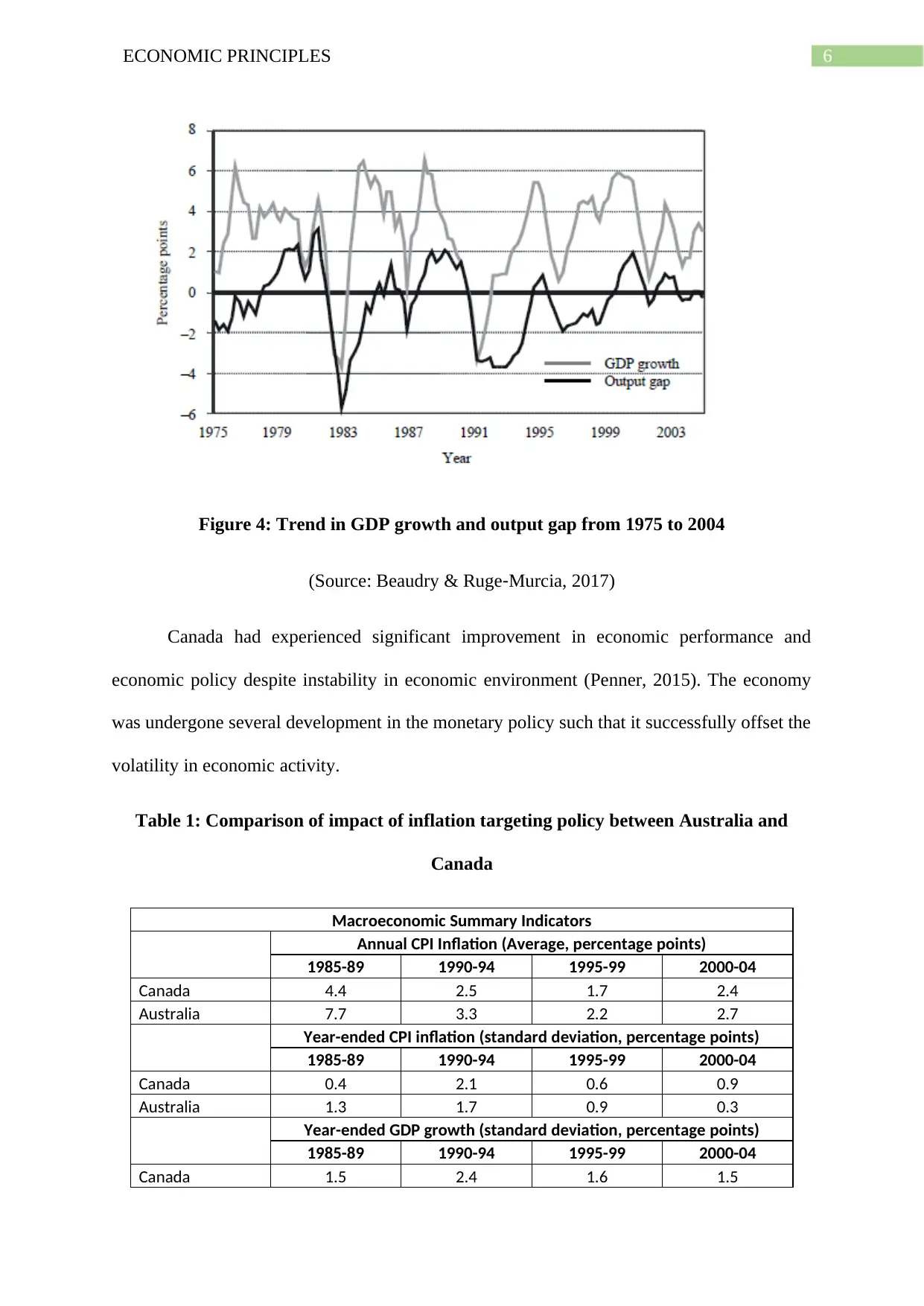
6ECONOMIC PRINCIPLES
Figure 4: Trend in GDP growth and output gap from 1975 to 2004
(Source: Beaudry & Ruge‐Murcia, 2017)
Canada had experienced significant improvement in economic performance and
economic policy despite instability in economic environment (Penner, 2015). The economy
was undergone several development in the monetary policy such that it successfully offset the
volatility in economic activity.
Table 1: Comparison of impact of inflation targeting policy between Australia and
Canada
Macroeconomic Summary Indicators
Annual CPI Inflation (Average, percentage points)
1985-89 1990-94 1995-99 2000-04
Canada 4.4 2.5 1.7 2.4
Australia 7.7 3.3 2.2 2.7
Year-ended CPI inflation (standard deviation, percentage points)
1985-89 1990-94 1995-99 2000-04
Canada 0.4 2.1 0.6 0.9
Australia 1.3 1.7 0.9 0.3
Year-ended GDP growth (standard deviation, percentage points)
1985-89 1990-94 1995-99 2000-04
Canada 1.5 2.4 1.6 1.5
Figure 4: Trend in GDP growth and output gap from 1975 to 2004
(Source: Beaudry & Ruge‐Murcia, 2017)
Canada had experienced significant improvement in economic performance and
economic policy despite instability in economic environment (Penner, 2015). The economy
was undergone several development in the monetary policy such that it successfully offset the
volatility in economic activity.
Table 1: Comparison of impact of inflation targeting policy between Australia and
Canada
Macroeconomic Summary Indicators
Annual CPI Inflation (Average, percentage points)
1985-89 1990-94 1995-99 2000-04
Canada 4.4 2.5 1.7 2.4
Australia 7.7 3.3 2.2 2.7
Year-ended CPI inflation (standard deviation, percentage points)
1985-89 1990-94 1995-99 2000-04
Canada 0.4 2.1 0.6 0.9
Australia 1.3 1.7 0.9 0.3
Year-ended GDP growth (standard deviation, percentage points)
1985-89 1990-94 1995-99 2000-04
Canada 1.5 2.4 1.6 1.5
Paraphrase This Document
Need a fresh take? Get an instant paraphrase of this document with our AI Paraphraser
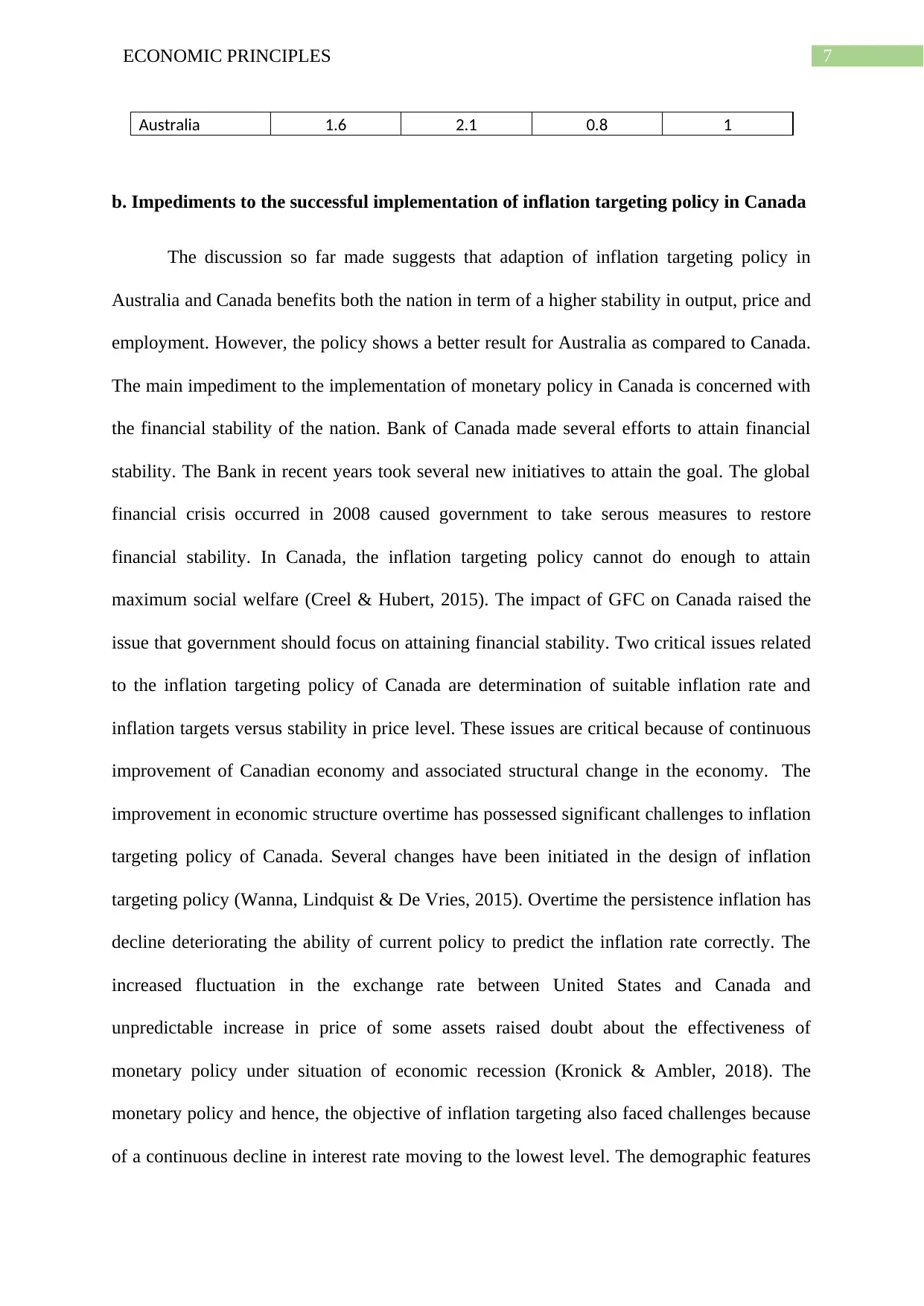
7ECONOMIC PRINCIPLES
Australia 1.6 2.1 0.8 1
b. Impediments to the successful implementation of inflation targeting policy in Canada
The discussion so far made suggests that adaption of inflation targeting policy in
Australia and Canada benefits both the nation in term of a higher stability in output, price and
employment. However, the policy shows a better result for Australia as compared to Canada.
The main impediment to the implementation of monetary policy in Canada is concerned with
the financial stability of the nation. Bank of Canada made several efforts to attain financial
stability. The Bank in recent years took several new initiatives to attain the goal. The global
financial crisis occurred in 2008 caused government to take serous measures to restore
financial stability. In Canada, the inflation targeting policy cannot do enough to attain
maximum social welfare (Creel & Hubert, 2015). The impact of GFC on Canada raised the
issue that government should focus on attaining financial stability. Two critical issues related
to the inflation targeting policy of Canada are determination of suitable inflation rate and
inflation targets versus stability in price level. These issues are critical because of continuous
improvement of Canadian economy and associated structural change in the economy. The
improvement in economic structure overtime has possessed significant challenges to inflation
targeting policy of Canada. Several changes have been initiated in the design of inflation
targeting policy (Wanna, Lindquist & De Vries, 2015). Overtime the persistence inflation has
decline deteriorating the ability of current policy to predict the inflation rate correctly. The
increased fluctuation in the exchange rate between United States and Canada and
unpredictable increase in price of some assets raised doubt about the effectiveness of
monetary policy under situation of economic recession (Kronick & Ambler, 2018). The
monetary policy and hence, the objective of inflation targeting also faced challenges because
of a continuous decline in interest rate moving to the lowest level. The demographic features
Australia 1.6 2.1 0.8 1
b. Impediments to the successful implementation of inflation targeting policy in Canada
The discussion so far made suggests that adaption of inflation targeting policy in
Australia and Canada benefits both the nation in term of a higher stability in output, price and
employment. However, the policy shows a better result for Australia as compared to Canada.
The main impediment to the implementation of monetary policy in Canada is concerned with
the financial stability of the nation. Bank of Canada made several efforts to attain financial
stability. The Bank in recent years took several new initiatives to attain the goal. The global
financial crisis occurred in 2008 caused government to take serous measures to restore
financial stability. In Canada, the inflation targeting policy cannot do enough to attain
maximum social welfare (Creel & Hubert, 2015). The impact of GFC on Canada raised the
issue that government should focus on attaining financial stability. Two critical issues related
to the inflation targeting policy of Canada are determination of suitable inflation rate and
inflation targets versus stability in price level. These issues are critical because of continuous
improvement of Canadian economy and associated structural change in the economy. The
improvement in economic structure overtime has possessed significant challenges to inflation
targeting policy of Canada. Several changes have been initiated in the design of inflation
targeting policy (Wanna, Lindquist & De Vries, 2015). Overtime the persistence inflation has
decline deteriorating the ability of current policy to predict the inflation rate correctly. The
increased fluctuation in the exchange rate between United States and Canada and
unpredictable increase in price of some assets raised doubt about the effectiveness of
monetary policy under situation of economic recession (Kronick & Ambler, 2018). The
monetary policy and hence, the objective of inflation targeting also faced challenges because
of a continuous decline in interest rate moving to the lowest level. The demographic features
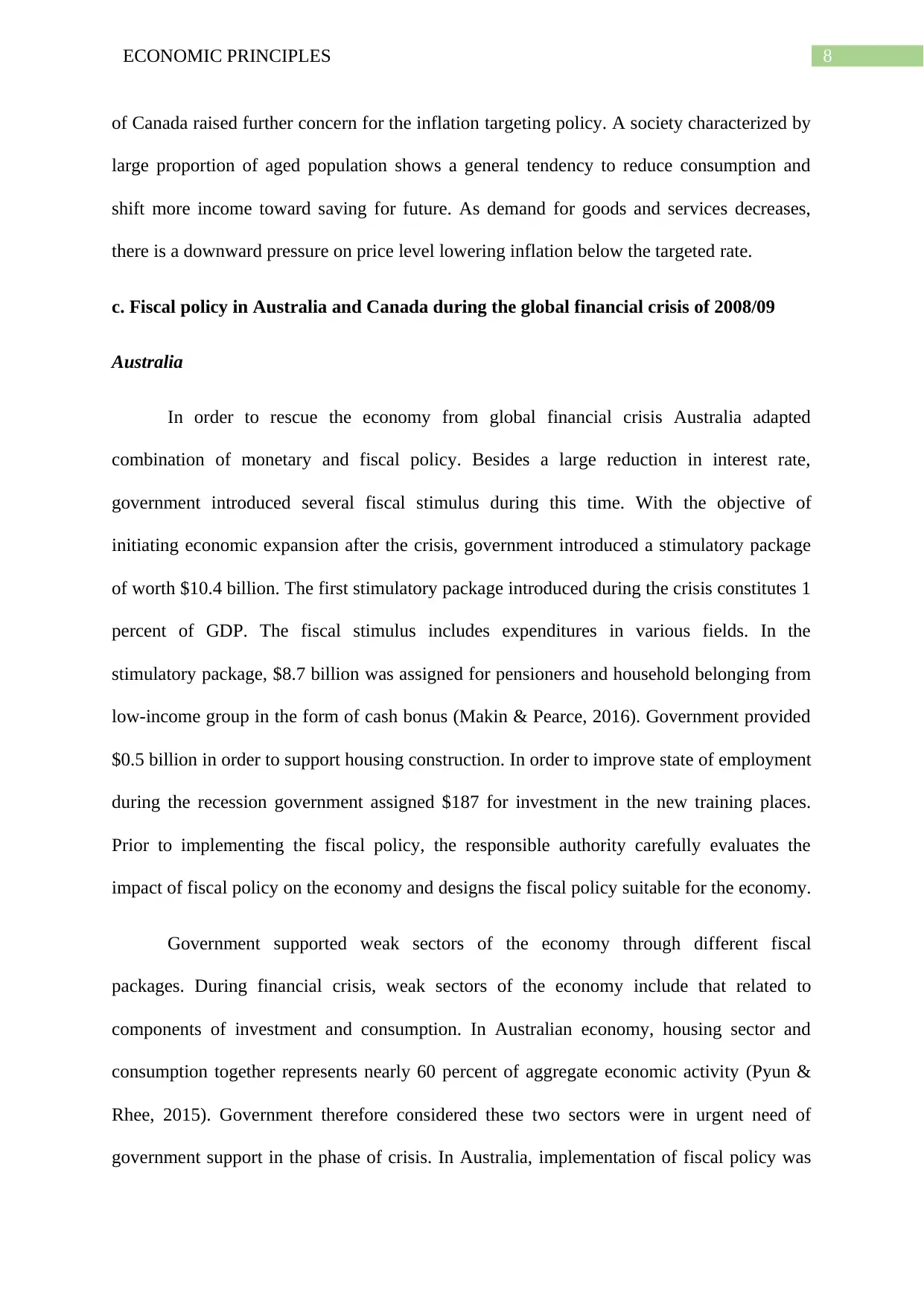
8ECONOMIC PRINCIPLES
of Canada raised further concern for the inflation targeting policy. A society characterized by
large proportion of aged population shows a general tendency to reduce consumption and
shift more income toward saving for future. As demand for goods and services decreases,
there is a downward pressure on price level lowering inflation below the targeted rate.
c. Fiscal policy in Australia and Canada during the global financial crisis of 2008/09
Australia
In order to rescue the economy from global financial crisis Australia adapted
combination of monetary and fiscal policy. Besides a large reduction in interest rate,
government introduced several fiscal stimulus during this time. With the objective of
initiating economic expansion after the crisis, government introduced a stimulatory package
of worth $10.4 billion. The first stimulatory package introduced during the crisis constitutes 1
percent of GDP. The fiscal stimulus includes expenditures in various fields. In the
stimulatory package, $8.7 billion was assigned for pensioners and household belonging from
low-income group in the form of cash bonus (Makin & Pearce, 2016). Government provided
$0.5 billion in order to support housing construction. In order to improve state of employment
during the recession government assigned $187 for investment in the new training places.
Prior to implementing the fiscal policy, the responsible authority carefully evaluates the
impact of fiscal policy on the economy and designs the fiscal policy suitable for the economy.
Government supported weak sectors of the economy through different fiscal
packages. During financial crisis, weak sectors of the economy include that related to
components of investment and consumption. In Australian economy, housing sector and
consumption together represents nearly 60 percent of aggregate economic activity (Pyun &
Rhee, 2015). Government therefore considered these two sectors were in urgent need of
government support in the phase of crisis. In Australia, implementation of fiscal policy was
of Canada raised further concern for the inflation targeting policy. A society characterized by
large proportion of aged population shows a general tendency to reduce consumption and
shift more income toward saving for future. As demand for goods and services decreases,
there is a downward pressure on price level lowering inflation below the targeted rate.
c. Fiscal policy in Australia and Canada during the global financial crisis of 2008/09
Australia
In order to rescue the economy from global financial crisis Australia adapted
combination of monetary and fiscal policy. Besides a large reduction in interest rate,
government introduced several fiscal stimulus during this time. With the objective of
initiating economic expansion after the crisis, government introduced a stimulatory package
of worth $10.4 billion. The first stimulatory package introduced during the crisis constitutes 1
percent of GDP. The fiscal stimulus includes expenditures in various fields. In the
stimulatory package, $8.7 billion was assigned for pensioners and household belonging from
low-income group in the form of cash bonus (Makin & Pearce, 2016). Government provided
$0.5 billion in order to support housing construction. In order to improve state of employment
during the recession government assigned $187 for investment in the new training places.
Prior to implementing the fiscal policy, the responsible authority carefully evaluates the
impact of fiscal policy on the economy and designs the fiscal policy suitable for the economy.
Government supported weak sectors of the economy through different fiscal
packages. During financial crisis, weak sectors of the economy include that related to
components of investment and consumption. In Australian economy, housing sector and
consumption together represents nearly 60 percent of aggregate economic activity (Pyun &
Rhee, 2015). Government therefore considered these two sectors were in urgent need of
government support in the phase of crisis. In Australia, implementation of fiscal policy was
⊘ This is a preview!⊘
Do you want full access?
Subscribe today to unlock all pages.

Trusted by 1+ million students worldwide

9ECONOMIC PRINCIPLES
followed by a discretionary policy that is well designed, targeted, temporary, and
implemented timely. Housing sector received an immediate government assistance in the
form of first homebuyers grant aimed to help first buyers of new home in Australia. To
support house consumption government grants were given to pensioners, cares, seniors and
low-income households.
Canada
Canada like Australia took several fiscal policy measures during global financial
crisis. For economic recovery and expansion of economic activity expansionary fiscal policy
was taken by the government. In January 2009, government introduced first economic action
plan. Government budget though showed a commitment towards efficient fiscal management
but there was a clear shift towards fiscal expansion. In the short run, economic activities had
been stabilized through introduction of several stimulatory packages. Government undertook
different policy measures as a part of fiscal expansion (Good & Lindquist, 2015). The
expansionary fiscal policy measures include reduction in income tax, tax credit to different
targeted group and boost in government spending stimulate domestic demand. Government
spent approximately $8.3 billion of skills development program of Canadians. The proposed
policy aimed to support those who had lost their jobs during the crisis and were searching for
new jobs. With the objective of encouraging housing construction, government offered a tax
credit amounts $7.8 billion. For funding infrastructural investment, government spent
approximately $12 billion. In order to support crisis-attacked sectors like auto, forestry and
manufacturing government assigned fund worth $7.5 billion. Through its spending
government target to give maximum possible support to Canadian economy. The stimulatory
packages given to different sectors of the economy significantly increased government
spending. Reduction in income and tax credits given to different sectors lowered earnings of
followed by a discretionary policy that is well designed, targeted, temporary, and
implemented timely. Housing sector received an immediate government assistance in the
form of first homebuyers grant aimed to help first buyers of new home in Australia. To
support house consumption government grants were given to pensioners, cares, seniors and
low-income households.
Canada
Canada like Australia took several fiscal policy measures during global financial
crisis. For economic recovery and expansion of economic activity expansionary fiscal policy
was taken by the government. In January 2009, government introduced first economic action
plan. Government budget though showed a commitment towards efficient fiscal management
but there was a clear shift towards fiscal expansion. In the short run, economic activities had
been stabilized through introduction of several stimulatory packages. Government undertook
different policy measures as a part of fiscal expansion (Good & Lindquist, 2015). The
expansionary fiscal policy measures include reduction in income tax, tax credit to different
targeted group and boost in government spending stimulate domestic demand. Government
spent approximately $8.3 billion of skills development program of Canadians. The proposed
policy aimed to support those who had lost their jobs during the crisis and were searching for
new jobs. With the objective of encouraging housing construction, government offered a tax
credit amounts $7.8 billion. For funding infrastructural investment, government spent
approximately $12 billion. In order to support crisis-attacked sectors like auto, forestry and
manufacturing government assigned fund worth $7.5 billion. Through its spending
government target to give maximum possible support to Canadian economy. The stimulatory
packages given to different sectors of the economy significantly increased government
spending. Reduction in income and tax credits given to different sectors lowered earnings of
Paraphrase This Document
Need a fresh take? Get an instant paraphrase of this document with our AI Paraphraser

10ECONOMIC PRINCIPLES
government expanding fiscal deficit. During global financial crisis, Canadian government
took extraordinary and temporary measures to restore stability in the economy.
d. Negative effect of recession on Australia and Canada
The global financial crisis that was initially began in United State in 2008 affected
several other economies in the world. With a recessionary pressure in United State, Canada
experienced a recession. The financial market in United State collapsed with sub-prime
mortgage crisis in housing market (Vanstone & Hahn, 2017). As the crisis spread to Canada,
there was a sharp decline in consumption and business investment. With a considerable
decline in export, nearly by 16%, Gross Domestic Product of Canada contracted by 3.3
percent. Business investment declined steadily by 22 percent, along with a fall in investment
in machinery and new buildings.
The impact of GFC on Australian economy on the other hand was minimal. Australia
though not completely escape from attack of the crisis the effect on Australia was relatively
smaller compared to other nations (Mollah, Quoreshi & Zafirov, 2016). Following the crisis,
Australian economy experienced period of uncertainty due to slower economic growth and
increase in unemployment.
The risk of global financial crisis on Australia and Canada were relatively less
compared to other nations. Australia however positioned itself to a better position than
Canada by better minimizing the risk. The minimal risk of Australian economy from the
crisis was little exposure of Australia banks and financial sectors to the position of financial
sector in United State. Canadian banks in contrast are more vulnerable to financial sectors of
United State. Some of the major subsidiaries of some Canadian banks were located in United
State and hence, directly integrated with financial crisis of United State (Dungey & Gajurel,
2015). The credit market of Canada was largely impacted by the global financial crisis.
government expanding fiscal deficit. During global financial crisis, Canadian government
took extraordinary and temporary measures to restore stability in the economy.
d. Negative effect of recession on Australia and Canada
The global financial crisis that was initially began in United State in 2008 affected
several other economies in the world. With a recessionary pressure in United State, Canada
experienced a recession. The financial market in United State collapsed with sub-prime
mortgage crisis in housing market (Vanstone & Hahn, 2017). As the crisis spread to Canada,
there was a sharp decline in consumption and business investment. With a considerable
decline in export, nearly by 16%, Gross Domestic Product of Canada contracted by 3.3
percent. Business investment declined steadily by 22 percent, along with a fall in investment
in machinery and new buildings.
The impact of GFC on Australian economy on the other hand was minimal. Australia
though not completely escape from attack of the crisis the effect on Australia was relatively
smaller compared to other nations (Mollah, Quoreshi & Zafirov, 2016). Following the crisis,
Australian economy experienced period of uncertainty due to slower economic growth and
increase in unemployment.
The risk of global financial crisis on Australia and Canada were relatively less
compared to other nations. Australia however positioned itself to a better position than
Canada by better minimizing the risk. The minimal risk of Australian economy from the
crisis was little exposure of Australia banks and financial sectors to the position of financial
sector in United State. Canadian banks in contrast are more vulnerable to financial sectors of
United State. Some of the major subsidiaries of some Canadian banks were located in United
State and hence, directly integrated with financial crisis of United State (Dungey & Gajurel,
2015). The credit market of Canada was largely impacted by the global financial crisis.
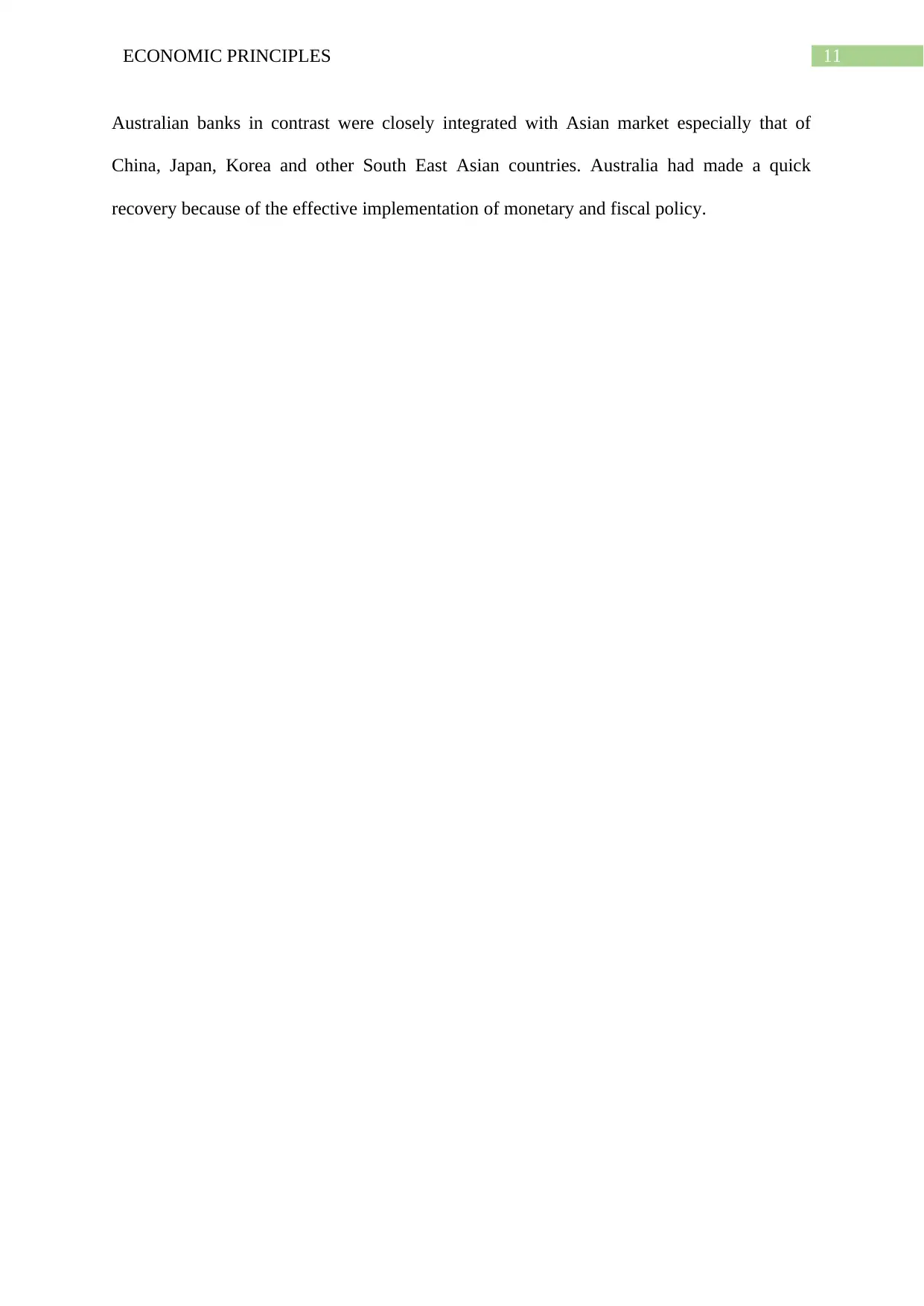
11ECONOMIC PRINCIPLES
Australian banks in contrast were closely integrated with Asian market especially that of
China, Japan, Korea and other South East Asian countries. Australia had made a quick
recovery because of the effective implementation of monetary and fiscal policy.
Australian banks in contrast were closely integrated with Asian market especially that of
China, Japan, Korea and other South East Asian countries. Australia had made a quick
recovery because of the effective implementation of monetary and fiscal policy.
⊘ This is a preview!⊘
Do you want full access?
Subscribe today to unlock all pages.

Trusted by 1+ million students worldwide
1 out of 14
Related Documents
Your All-in-One AI-Powered Toolkit for Academic Success.
+13062052269
info@desklib.com
Available 24*7 on WhatsApp / Email
![[object Object]](/_next/static/media/star-bottom.7253800d.svg)
Unlock your academic potential
Copyright © 2020–2025 A2Z Services. All Rights Reserved. Developed and managed by ZUCOL.





